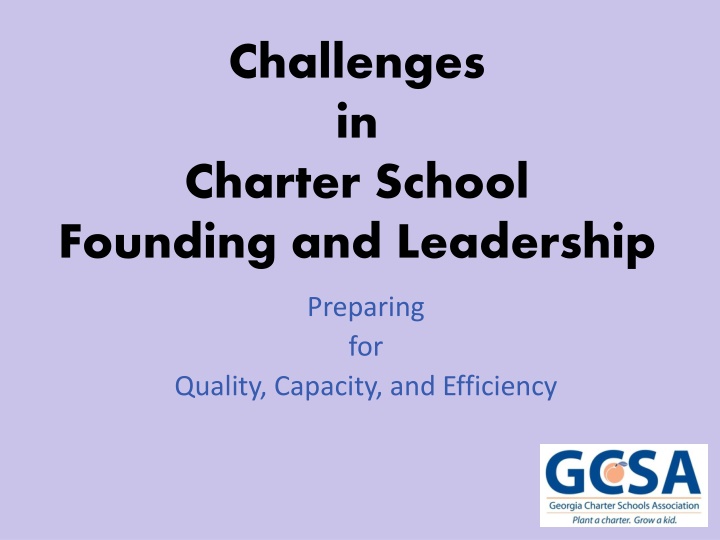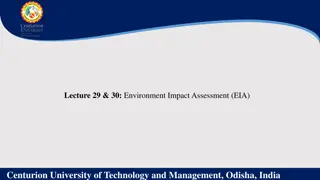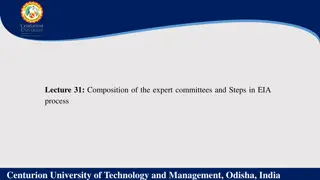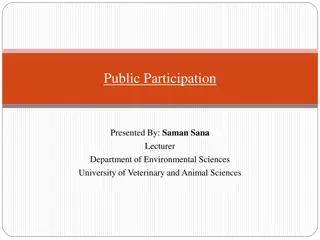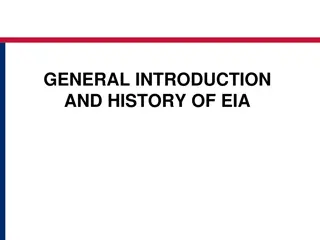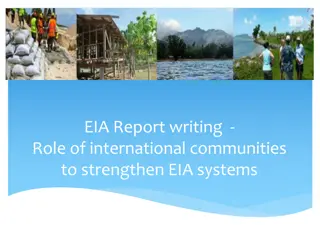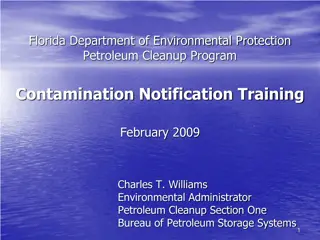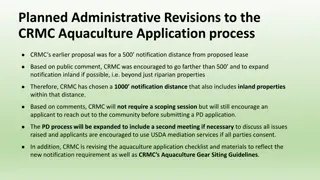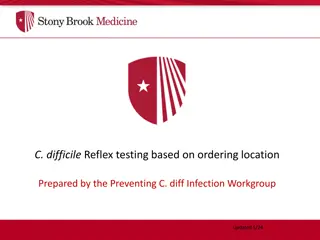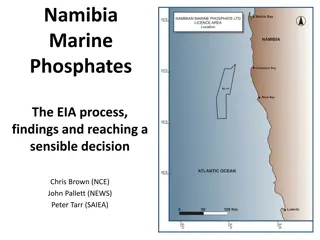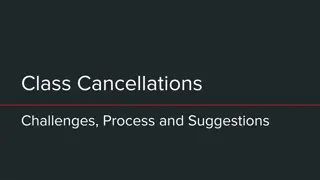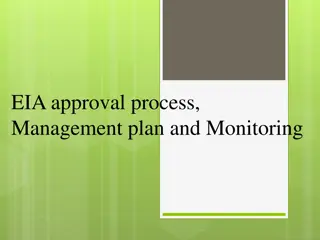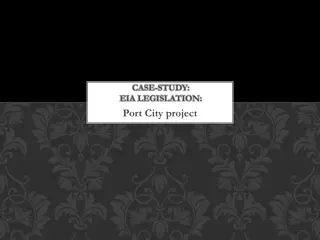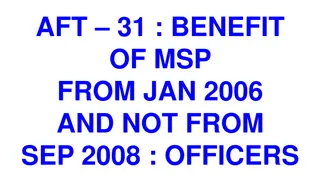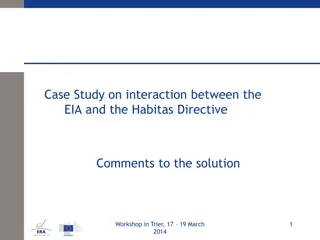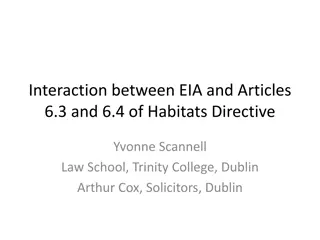Salient Features of 2006 Amendment to EIA Notification Process
The 2006 amendment to the Environmental Impact Assessment (EIA) notification process in India decentralized environmental clearance projects, categorizing them into two levels - Category A for national level appraisal and Category B for state level. The EIA cycle now includes screening, scoping, public hearing, and appraisal stages, ensuring environmentally safe and sustainable development while addressing shortcomings in the process.
Download Presentation

Please find below an Image/Link to download the presentation.
The content on the website is provided AS IS for your information and personal use only. It may not be sold, licensed, or shared on other websites without obtaining consent from the author.If you encounter any issues during the download, it is possible that the publisher has removed the file from their server.
You are allowed to download the files provided on this website for personal or commercial use, subject to the condition that they are used lawfully. All files are the property of their respective owners.
The content on the website is provided AS IS for your information and personal use only. It may not be sold, licensed, or shared on other websites without obtaining consent from the author.
E N D
Presentation Transcript
Challenges in Charter School Founding and Leadership Preparing for Quality, Capacity, and Efficiency
Presenters Eric Paisner Director of Organizational Strategy & Staff Counsel The National Alliance for Public Charter Schools Kelly Cadman Director of Education and Training The Georgia Charter Schools Association Juli Sergi Professional Learning Consultant 2
Charter Schools 4956 charter schools More than 365,000 on waitlists 39 states + DC Most charters in a state: CA 820; Least: VA - 4 GA has 121 charters. Only 65 are start-ups There is room for growth!!! Market Share 7 markets have more than 25% of all students in charters: New Orleans (55%) DC (36%) Detroit (32%) Kansas City (29%) Dayton (27%) Youngstown (26%) St. Louis (25%) GA s market share is about 4%! There is room for growth!!! 3
39% qualified for FRL In GA 60% are eligible for FRL 57% are in cities; 13% are in rural areas; 30% are in towns or suburbs In GA, 4 metro districts enroll 65% of the charter population Untapped GA areas! 29% of schools have been open 3 yrs; another 26% have been open 6 yrs average # of years open is 6.3 In GA, 41% of charters are 3 yrs We are a fast growing charter state! Charter Demographics Funding and Finance Average per pupil funding as a percent of traditional public schools 78% GA charter school per pupil funding average = $7,216 or 81% of traditional school funding Academic Achievement 61% of all charters made AYP for 2007-2008 In GA , 77% of charters made AYP for 2007-2008 Startup charters are outpacing traditional public schools in academic achievement 4
Charters are growing by a rate of approximately 15% annually with the national attention, this rate could easily increase in the coming years . Critical need for groups to plan high quality charters to support the growth and success of the charter reform movement and to increase impact nationwide in student achievement. High demand and need for 6,000-21,000 effective new charter school leaders in the next 10 years to address openings due to attrition and new schools authorized across the nation. Source: Charter School Executives: toward a New Generation of Leadership, Nov. 2008, National Alliance for Public Charter Schools 5
Growth of the Movement Focuses Attention on Success of Its Charters Academics and Finances Accountability QUALITY Capacity to Effectively Govern and Manage Sound Business Practices 6
Session Focus Keys to Quality School Development Hiring and Retaining Quality Leadership 7
Did You Know Center for Educational Reform did a study on 588 charter schools that closed 2/3 were reported closed due to financial issues (enrollment, mismanaged financial affairs, etc.) Brian Carpenter (author of Charter School Board University) did a study on 100 schools that closed. Prevalent in most schools that closed .finance and sloppy governance. http://www.nationalcharterschools.org/resource_listing_detai l.php?id=152 8
A good plan is like a road map: it shows the final destination and usually the best way to get there. - H. Stanley Judd 9
Development and operation of a high quality charter school requires comprehensive planning in many areas Governance Governance Legal & Compliance Legal & Compliance Financial Financial Operations Operations Safety & Risk Mgmt. Safety & Risk Mgmt. Community & Culture Community & Culture Facilities & Grounds Facilities & Grounds Marketing & Marketing & Enrollment Enrollment Leadership Leadership & & Staffing Staffing Academic Academic Program Continuous Assessment & Improvement Program
Adequate Planning of a charter school and effective operations also considers: Governance Governance Legal & Legal & Compliance Compliance Financial Financial People Legal & Legal & Regs. Regs. Systems Operations Operations Safety & Risk Safety & Risk Mgmt. Mgmt. Community & Community & Culture Culture Facilities & Facilities & Grounds Grounds Marketing & Marketing & Enrollment Enrollment Leadership Leadership & & Staffing Staffing Academic Academic Program Program Cont. Assess. & Improv. Category (ex. Academic Program) Training Processes Budget Policies 11
Heres an example Academic Program Academic Program Legal & Legal & Regulatory Regulatory IDEA, ADA, Student Records AYP Reporting Academic Perf. to Authorizers Health and Safety FERPA Title II Title I People People Systems Systems Training Training Policies Policies Budget Budget Processes Processes Instructional Leaders Classroom Teachers SPED Gifted Remedial Para Support Media OT/PT/SLP, etc. Psychometrists Counselors Grading Reporting Web SPED Student Information System RTI Pedagogical Practices Classroom Management Health and Safety Standards and Assessment On Processes, Systems, or Legal/Reg. Certification of Staff (HQ) Meeting SACS requirements Grading Reporting Fieldtrips Supervision Curriculum Adoption Specific Programs Graduation Reqs. Gender Equity Class Size Textbook Adoption Internet Use and Safety Promotion and Retention Absences Hospital Homebound Furniture Instructional Materials Textbooks Library Books Printing for Forms (report cards, etc.) Personnel Salaries, Benefits and Retirement Contracted Services Transportation for SPED and fieldtrips Technology Professional Development Insurance Classroom and school wide discipline Scheduling and Calendar Professional Development and Collaboration Grading and Reporting SST RTI Testing for Programs Collecting Money and Accounting Using School Networks Media Center Checkout Not intended to be all inclusive 12
Remember the 2 commonalities in charter school closures? Finance Governance Ineffective Governance Enrollment Dominated by a founder or EMO Violations of fiduciary duties Micromanagement Violation of governing documents No plan for succession, rotation, or orientation Lack of functioning committee structure No strategic plan Failure to remove unproductive members Board size Lack of internal cohesion Excessive turn over Well intentioned people lacking capacity to govern Marketing Living up to the mission and vision Location Staff (leadership, teachers, etc.) Policies & Procedures Image Recommended 300+ for sustainability Managing Financial Affairs Qualified CFO and business manager Shared Board Accountability Fiscal Control Policies & Procedures Audit Compliance Budgeting appropriately and monitoring Contingencies With contributions from the work of Dr. Brian Carpenter, Charter School Board University 13
Activity Read the case study. Determine what went wrong How would you have planned differently or how would you respond if you were already operational? Put your name on the back of your scenario turn it in for a drawing later 14
To Sum It Up Understand the breadth of the task. Identify key requirements to develop a solid plan. Create a Critical Path Plan for development including the key requirements, timelines, and individuals with expertise, time, and commitment to lend to the task. 15
Leadership is the capacity to translate vision into reality. - Warren G. Bennis 16
The Big Idea Robert Marzano, in his books Classroom Instruction that Works and What Works In Schools: Translating Research into Action considers the critical role of Leadership. He says Leadership could be considered the single most important aspect of effective school reform Indeed, research has shown that next to the effectiveness of the teacher, the single factor that has the most direct impact on student achievement is the effectiveness of the leader. (Waters, Marzano, McNulty, 2003); Leithwood, Seashore Louis, Anderson, and Wahlstrom, 2004) 17
Did You Know Why Charter Leaders Come to the Charter Sector 86% come because of educational mission 71% were seeking a challenge 66% came because of the students served 42% supported the charter movement 37% came because of location 15% were looking for career advancement 13% come because of pay and benefits Why They Stay Increased autonomy in leadership More collegiality Chance to serve a targeted group of students Commitment to making a difference Source: Working Without a Safety Net: How Charter School Leaders Can Best Survive on the High Wire. National Charter School Research Project, University of Washington. Christine Campbell, Bethany Gross. September 2008, Seattle, Washington. 18
Did You Know Compared to traditional Public School Principals, Charter School Principals Slightly more who are younger (under the age of 40) Slightly more who are older and (over the age of 60) Are Less experienced Are comparable in race and gender Almost 40% of those in the study went straight from the classroom to principal ship leapfrogging over vice principal 87% come from an educational background On average Make less ($66,800 vs. $82,600) 25% reported taking a pay cut A Few More Stats 54% T7, T6, T5 in Leadership 5% T5 in area other than leadership 1% T4 In area other than leadership 40% No certification and/or not found in the PSC system 19
Did You Know Almost 10% of charter leaders leave each year (2004) 43% said they expect to leave within 3 years (2007) 71% said they expect to be gone within 5 years (2007) 92% said they expect to leave in the next 6-10 year (2007) Why they Leave Struggle with facilities, finances, and hiring Have little time for strategic planning Wear many hats and have little support Lack capacity or formal training in business management or educational leadership (sometimes both) Source: Working Without a Safety Net: How Charter School Leaders Can Best Survive on the High Wire. National Charter School Research Project, University of Washington. Christine Campbell, Bethany Gross. September 2008, Seattle, Washington. 20
What Does It Take to be a Charter School Leader? Community and Culture Development Hard Worker Hands-On, Actively Engaged Problem Solver Committed to Self-Development Forest AND Trees Shared philosophy Commitment to charter Pro-School Choice Pro Charter Ambassador Fundraiser, Grant Writer Diplomat for all stakeholders Intelligent Stellar communicator verbal & written Consensus Builder Integrity Strategic Planning (SIP, SDP) Instructional Leadership Curriculum Development Managerial Accounting Experience Financing Knowledge Risk Management Employee Relations Management Skills Policy and Procedure Multi-tasker, Wears Many Hats Resourceful, Self-Managing Legally Compliant Culture/Community Development Facility/Grounds Emotional Stability and Physical Stamina Legal and Regulatory
The Right Person to Drive the Bus THE EXECUTIVE Builds enduring greatness through personal humility and professional will Level 5 THE EFFECTIVE LEADER Catalyzes commitment to and vigorous pursuit of clear and compelling vision and stimulates high performance standards Level 4 THE COMPETENT MANAGER Organizes people and resources toward the effective and efficient pursuit of predetermined objectives Level 3 THE CONTRIBUTING TEAM MEMBER Contributes individual capabilities to the achievement of group objectives and works effectively with others in a group setting Level 2 THE HIGHLY CAPABLE INDIVIDUAL Makes productive contributions through talent, knowledge, skills, and good work habits Level 1 Jim Collins, Good to Great and the Social Sector, 2005. Printed with permission. May not be duplicated without permission of J. Collins. May not be shared electronically.
The Cost of an Ineffective Leader Staggering Losses of Teachers: Year 1=12% leave Year 2=19% have left Year 3=28% have left Year 4=34% have left Year 5-46% have left Richard Ingersoll, 2008 * Loss of teachers impacts student achievement and school sustainability! 23
Remember the main reasons for charter school leader attrition? Struggles with Facilities, Finances, and HR Has Little Time for Strategic Planning Wears Many Hats Little Support Lacks Capacity in Business or Education 24
Consider Some Solutions SPED Facilities/Maintenance Human Resources Partnerships EMO/CMO Non-profit or specific business (i.e., back office) Vendors Business/Education Succession Planning Mentoring, Managing Org Structures & Processes Educational Leadership Business Leadership On specific Topics Training 25
Activity Consider your own school plan for leadership. Consider these questions Who handles central office tasks (HR, finance, facilities, etc.)? How have you ensured your leader has time to strategically plan? What sort of support staff does your school have to share duties and responsibilities? Does your leader have any gaps in their training or education related to education or business? What could you do to support the school leader in any areas above that are weak? 26
The purpose of the CharterStart program is to provide technical assistance to charter school petitioners for the development of high quality charter schools. TOPICS: SERVICES: Legal and Practical Considerations Developing a business plan Funding, finance, and accounting Developing the instructional program Serving special populations Accountability (academic and financial) Facility Student services Human resources Fundraising and grants Risk management Operations Consulting for 1 year including: Grant review Petition review Budget review Small library Cohort group work sessions Advocacy on your behalf CharterStart Program Overview 27
Scope of the Program Direct instruction Simulation activities Group engagement 4-6 months Classroom Instruction Web Based Training Direct instruction Performance tasks Direct feedback Individualized cohort group meetings Mock interviews Petition review Business plan and budget review 1 year Consulting 28
The purpose of the CharterLeader program is to provide training, professional development, and mentoring that enables current and potential leaders to effectively manage charter schools that exceed the community s expectations. Educational Leadership Module Business Leadership Module Recruiting, Hiring, Managing, and Retaining Highly Effective Staff School improvement Plans and Processes Stakeholder Relations and Building Community Support Legal and Regulatory Matters Pertaining to Public Charter Schools Facilities Management Instructional Supervision Developing and Implementing Performance Management Systems Implementing a Standards-Based Instructional Program Developing a High Quality Assessment and Reporting Program Using Data Analysis to Drive Instructional Decisions Strategic Planning and Leadership Labor Relations Current Educational Issues Sustainability, Financial Accounting and Management, Budgeting, Fundraising and Grant Writing, Funding Cultivating a School Culture Reflecting the Charter Mission and Vision CharterStart Program Overview 29
Scope of the Program Direct instruction Simulation activities Group engagement Direct feedback Classroom Instruction Web Based Training Direct instruction Performance tasks Direct feedback Differentiated learning Substantial practice and application of skills in context Increasing responsibilities and engagement with stakeholders Direct feedback from mentor and program director Performance based assessment Practicum Experience 30
Additional GCSA Support A la Carte Trainings The Association also offers training on specific topics under CharterStart and CharterLeader that may help you build your school s or leader s capacity if you don t need the entire program. Quarterly Principal Meetings The Association facilitates opportunities for school leaders to interact, problem solve, and share resources. 31
Support from the PSC and DOE Division of Teacher and Leader provides programs and resources to enhance teacher and leader quality that include the following: Title II, Part A grant awards CLASS Keys and Leader Keys evaluation systems Professional Learning. Leader Keys Field Study Designs and conducts a field study of a new leader evaluation process to improve the quality and effectiveness of principals/administrators. The ten strands are the basis for the standards, elements, and rubrics. Curriculum Assessment Standards-Based Instruction Data Analysis Organizational Culture Professional Learning and Development Performance Management and Process Improvement Managing Operations Leading Change Relationship Development Professional Learning Provides leadership, technical assistance, resources, and consultative services to the Georgia education community in order to improve student learning through organizational development and professional learning (staff development). Professional Learning Unit Credits (PLUs) Application and Credit Program Approval (Comprehensive Plan for PLU Credit) 32
QUESTIONS 33
A Closing Thought The magic combination for success is: planning + intelligence + hard work + networking + building systems + follow through. 34
